What Is a Dabbling Duck?
Dabbling ducks, or puddle ducks, are an integral part of the wetlands ecosystem. They can be seen frequenting shallow waters, flooded fields, and marshy areas, where they feed by tilting instead of diving. When taking flight, they spring into the air instead of pattering across the water like other types of waterfowl. Most dabbling ducks swim with their tail held clear of the water, which gives them a unique silhouette when flying away. Their wings feature colorful, iridescent speculum (a rectangular patch at the hind edge of the wing) that makes them stand out among other birds in flight.
Dabbling Duck vs. Diving Duck: What Is the Difference?
Puddle ducks, also referred to as dabbling ducks, are characterized by their feeding habits and physical features. They generally feed on the surface of the water or in very shallow bottoms. Puddle ducks are not equipped with powerful muscles or large feet like their diving duck counterparts, which allows them to dive down several feet for food. A puddle duck’s feet are smaller since they do not need extra propulsion power for deeper dives.
In addition to different feeding habits, there is also a distinct difference in how these two types of ducks take flight when spooked or moving about. Dabblers typically spring straight up from the water’s surface, while divers must first gain momentum by running across the surface before taking off into flight.
1. Mallard
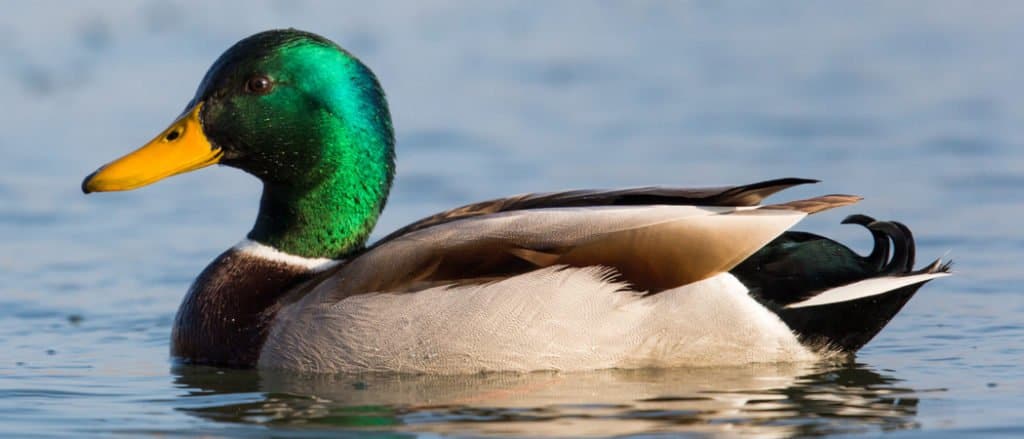
The male mallard has a distinct white neck ring that separates its green head from its chestnut-brown chest.
©Pascal Halder/Shutterstock.com
The mallard is the most common duck in the United States and can be found between the Appalachian and Rocky mountains. It is a dabbler and feeds off aquatic plants, such as seeds, rootlets, and tubers from swamp and river bottoms. The male mallard has a distinct white neck ring that separates its green head from its chestnut-brown chest. This species is one of the most recognizable ducks on Earth and is also the ancestor of several domestic breeds. With one of the widest breeding ranges in North America, it extends across northern parts of the U.S. up to Alaska’s Bering Sea coastlines.
2. Northern Pintail
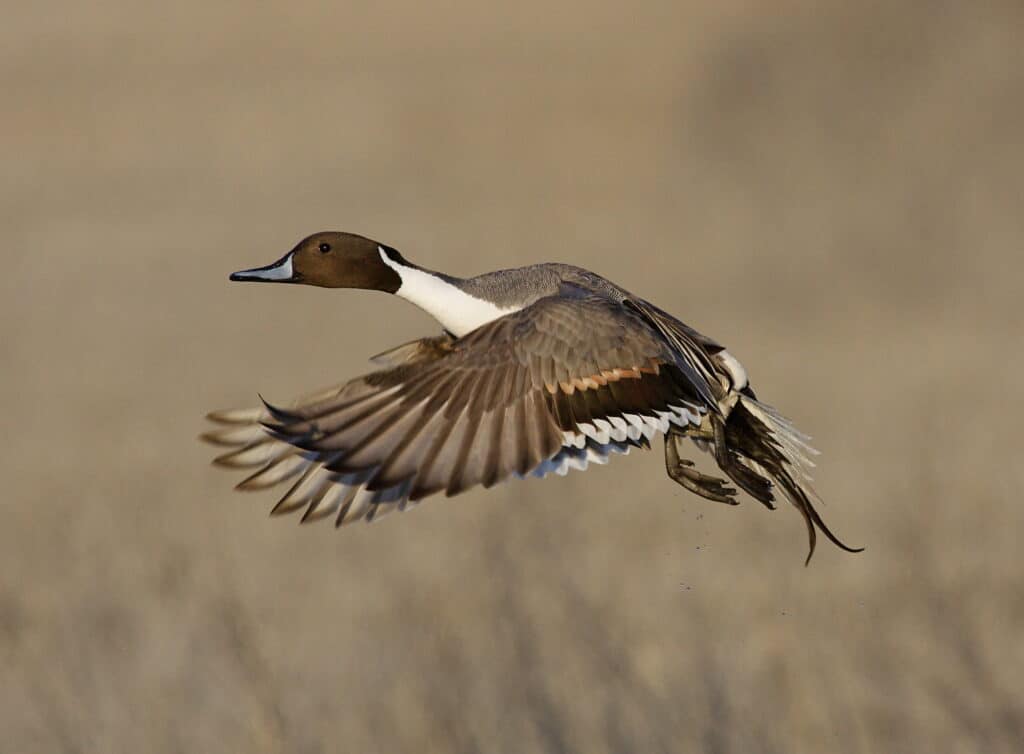
Northern pintails are distinctively long and slender ducks with lengthy wingspans, which earns them their nickname “greyhound of the air.
©Tom Reichner/Shutterstock.com
Northern pintails have a circumpolar breeding pattern, meaning they are found in the Northern Hemisphere. In North America, they breed throughout Alaska, the central Canadian Arctic, and western Greenland, stretching south to the western and central United States. These ducks prefer to nest in open areas near seasonal or semi-permanent wetlands in prairies and tundras with plenty of plant matter. Females typically nest on the ground in low or sparse vegetation far from water bodies and lay an average of 8 eggs per clutch.
Northern pintails are distinctively long and slender ducks with lengthy wingspans, which earns them their nickname “greyhound of the air.” They get their name from their elongated central tail feathers that constitute one-quarter of a drake’s body length.
These ducks feed by dabbling for food such as seeds and nutlets of moist soil plants, as well as using waste grain for sustenance. Unfortunately, northern pintail populations have significantly declined since the 1950s, falling from five to three million birds.
3. Gadwall

Female gadwalls nest in fields or meadows with islands or dikes nearby, laying an average of 7-12 eggs per clutch.
©Rudmer Zwerver/Shutterstock.com
Gadwall is a common species of North American dabbling duck, known for its lack of bright colors and late breeding season. They inhabit mainly grasslands and mixed Prairie regions in the United States and Canada, as well as wetland habitats of the Great Basin. Female gadwalls nest in fields or meadows with islands or dikes nearby, laying an average of 7-12 eggs per clutch.
These ducks’ diet consists mainly of aquatic vegetation such as pondweed, wigeon grass, water milfoil, and algae. They have also been observed eating seeds from smartweed, bulrush, and spike rush. As a result, they prefer to stay far away from the shoreline while feeding – usually much deeper than other dabbling ducks. Since improved wetland habitat conditions began in the late 1980s, there has been a significant increase in the population size of gadwalls across North America – estimates now total nearly 3 million birds!
4. Green-Winged Teal
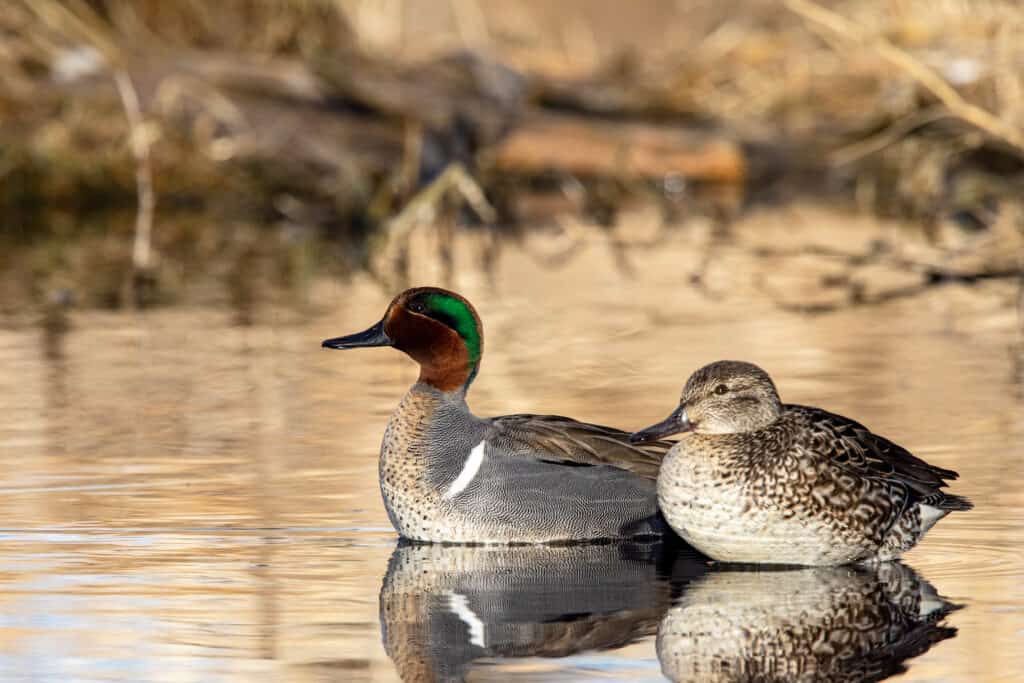
The most striking feature of the green-winged teal is the matching green crescent on their heads and green patch on their wings.
©J Edwards Photography/Shutterstock.com
Green-winged teals are an abundant species of waterfowl found across North America. They breed from Alaska to the Maritime Provinces and south into central California, Utah, Colorado, Nebraska, Minnesota, and Wisconsin.
These ducks prefer shallow permanent ponds near boreal forests with an abundance of emergent vegetation, such as cattails or bulrushes. However, they will also nest in Prairie Pothole country or other areas with dense vegetation. During the breeding season, female green-winged teal lay an average of 8-9 eggs.
Green-winged teal is the smallest dabbling duck found in North America, with a short neck and small bill. Male green-winged teals have chestnut-colored heads with iridescent green and purple extending from their eyes all the way down to the nape of their neck.
Green-winged teal feeds on seeds of sedges, smartweeds, pondweeds, grasses, and aquatic insects. The population numbers for green-winged teals have been steadily increasing since reaching their lowest point at 722,000 birds in 1962.
5. Wood Duck
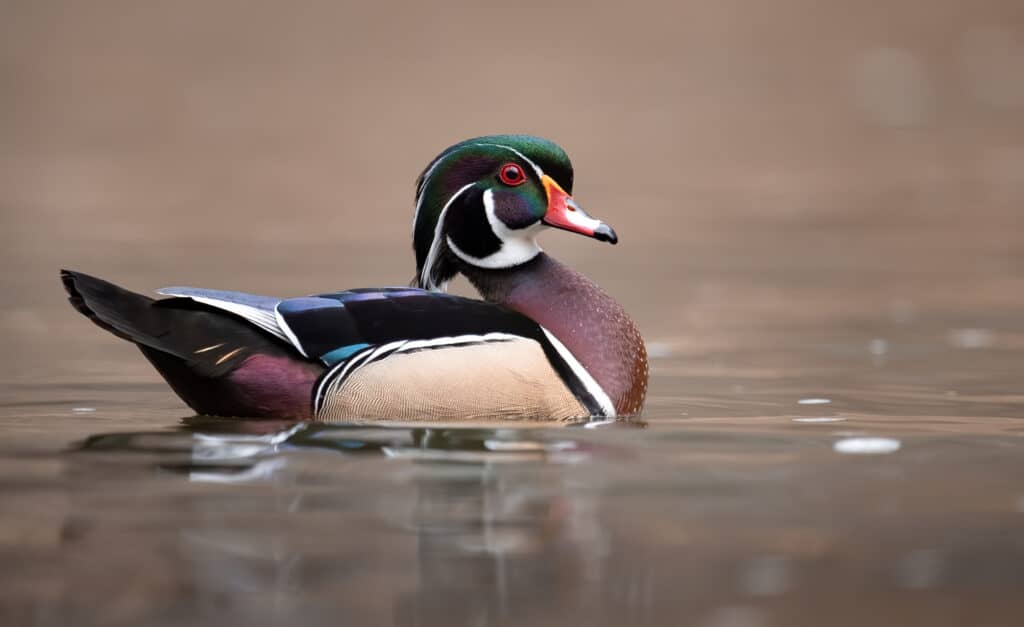
Wood ducks birds prefer habitats such as forested swamps and freshwater marshes for nesting sites.
©Harry Collins Photography/Shutterstock.com
Wood ducks are medium-sized dabbling ducks that breed across much of the central and eastern United States, southeastern Canada, and along the Pacific coast from California to British Columbia. The highest breeding densities occur in the Mississippi Alluvial Valley, though their range has expanded westward into the Great Plains region following the development of wooded riparian corridors.
These birds prefer habitats such as forested swamps and freshwater marshes for nesting sites. Females typically lay an average of 12 bone-white eggs in tree cavities or nest boxes. In terms of appearance, male wood ducks have a crested head that is iridescent green and purple with white stripes leading from the eye to the end of the crest. The throat is also white, while the chest plumage is burgundy with small flecks of white scattered throughout it.
Regarding residency status, 30-75 percent of these species remain permanent residents in both eastern and western United States regions. Migratory individuals utilize the Atlantic Flyway traveling further north towards New Brunswick before heading south all way down east Texas and West Indies area during the winter months.
6. Blue-Winged Teal
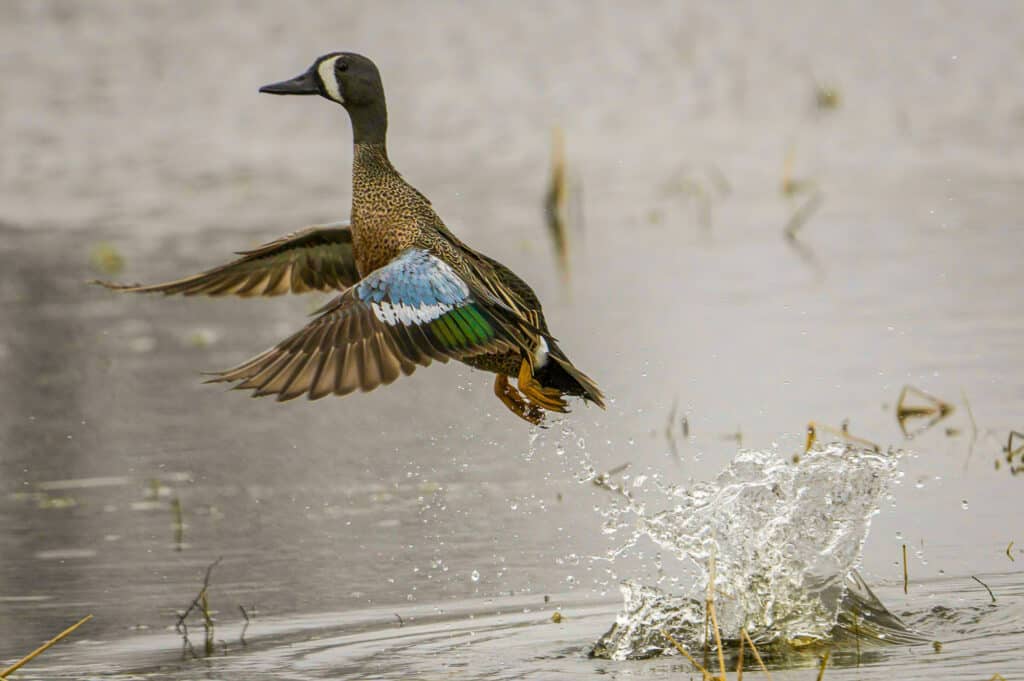
The male blue-winged teal has a steel gray head with a white crescent trimmed in black in front of their eyes.
©iStock.com/Brian Reinke
The blue-winged teal is one of the most common dabbling ducks in North America, and their numbers have increased significantly over the past ten years. They breed primarily in wetland areas that have plenty of grass, like shallow marshes and ditches that have flooded. Females often change breeding sites each year depending on conditions and typically lay ten eggs each season.
Male blue-winged teal has a steel gray head with a white crescent trimmed in black in front of their eyes. The breast is tan with brown spots, and there is a white spot on the rear end.
Blue-winged teals feed by dabble feeding, which involves taking up small amounts of vegetative parts from aquatic plants and their seeds, as well as aquatic invertebrates.
Thanks to favorable prairie wetland conditions across much of central North America, the blue-winged teal population has been stable at an average of 6 million individuals during the past decade.
7. American Wigeon

American wigeon feeds mainly on grasses and sedges found in wet meadows and pastures where they graze.
©Gregory Johnston/Shutterstock.com
American wigeon is unique among dabbling ducks as they prefer to nest farther north than many others. They breed throughout northern Canada and Alaska in lakes and marshy areas with dry sedge-lined meadows that contain submerged vegetation.
American wigeons are easily identifiable by the male’s white patch from the forehead to the middle of the crown combined with an iridescent green band from the eye to the back of the head, which contrasts against his blue-tipped bill.
On average, each female will lay nine eggs in their nests during the breeding season. American wigeon feeds mainly on grasses and sedges found in wet meadows and pastures where they graze. They also use their bills for probing into the mud at times when searching for food, such as invertebrates or crustaceans.
Summary of 7 Types of Dabbling Ducks
- Mallard
- Northern Pintail
- Gadwall
- Green-Winged Teal
- Wood Duck
- Blue-Winged Teal
- American Wigeon
The photo featured at the top of this post is © J Edwards Photography/Shutterstock.com
Sources
- Ducks Unlimited, Available here: https://www.ducks.org/hunting/waterfowl-id/
- MISSOURI DEPARTMENT OF CONSERVATION, Available here: https://mdc.mo.gov/blogs/discover-nature-notes/dabblers-vs-divers-1
- SORA, Available here: https://sora.unm.edu/sites/default/files/journals/auk/v116n03/p0792-p0805.pdf
Thank you for reading! Have some feedback for us? Contact the AZ Animals editorial team.






